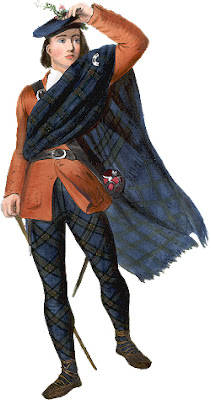
Sixteenth century onwards and had probably been worn for quite some time before that over the saffron tunic - the main article of clothing worn by the Irish.
It was reported that in very bad weather - high winds, frost or snow - the Highlander would dip his plaid in water and then lie down in it. We're told that wetting it like that made the wool swell so that the plaid would give better protection against the wind and cold air. In sub-zero temperatures, it's said that the dipping would result in a thin glaze of ice on the outside surface which would further insulate the occupant. Wrapped up like this with his head under the blanket, the Highlander's breath would then create a warm and moist atmosphere around him which would keep him cosy during the night! As you can imagine, if the poorer Highlanders worked and slept in their plaids they must have been pretty smelly as reported in 1726 in a letter from Captain Burt, an English engineer. " the plaid serves the ordinary people for a cloak by day and bedding at night imbibes so much perspiration that no one day can free it from the filthy smell"
Thearisaidh was the elegant and practical choice for the woman who lived and worked in the beautiful green highlands of Scotland. over a millenia ago. The arisiadhwas worn belted around the waist and the extra fabric could be pinned at the breast and worn up as a hood to keep warm in the rain and cold. The excess could also be rolled and tied about the waist or tucked into the belt in warmer weather and to keep it from interfering with chores. It also provided lots of 'pockets' to perhaps stash a spindle and wool or herbs gathered from the fields.
It was a loose garment made up of around six ells (18 feet/5 metres) of double tartan - Highland looms could only weave a maximum width of 25 to 30 inches (65 - 75 cms) so two lengths had to be sewn together down their long edge to make the plaid (from 'pladjer' - the Gaelic for blanket).
Historians have foisted onto us the idea that the Highlander laid this great expanse of fabric onto the ground and carefully folded it into pleats until its length was reduced to about 5 feet (1.5m). He then lay down on his back on top of it so that the bottom edge almost reached to his knees and gathered it around himself, securing it round his waist by a leather belt. He would then stand up and arrange the unpleated top portion around his shoulders, tucking the corners into his belt to form ingenious pockets.
No comments:
Post a Comment